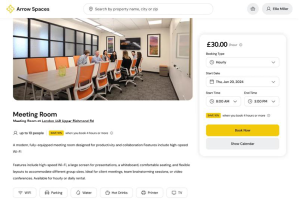Transforming Vacant Offices into Thriving Flexible Workspaces: A Guide for Commercial Real Estate Providers
The commercial office landscape is in a state of flux, driven by changing tenant demands and technological advancements. As traditional office spaces face low occupancy rates, commercial real estate providers must adapt by transforming these vacant offices into thriving flexible work environments. This blog explores how asset managers and office providers can leverage this trend, highlighting the key role of a unified software solution in addressing voids and diversifying real estate offerings.

The Shift to Flexible Workspaces
The rise of hybrid working models and changing corporate needs have left many traditional office spaces vacant. However, this challenge presents a unique opportunity for commercial real estate providers to diversify their offerings and tap into the growing demand for flexible workspaces.
Flexible workspaces have emerged as a game changer in commercial real estate. These adaptable spaces are tailored to meet the evolving needs of modern businesses, offering various configurations, from private offices to coworking areas and on demand meeting rooms. An independent survey commissioned by workspace provider, infinitSpace, revealed that in the past two years, 23% of UK Landlords have converted their traditional offices into coworking spaces, with another 22% planning to make the switch to flexible spaces within the next two years.
Benefits for Landlords and Investors
- Increased Financial Sustainability: Diversifying your real estate portfolio creates a far more robust business model. By moving a portion of your traditional office space into flex, you protect your business against the unexpected impact of uncontrollable factors and market disruptions. At the same time flexible workspaces can also increase revenue per square foot.
- Increased Property Value: By converting traditional office spaces into flexible environments, landlords can charge a premium, thus enhancing net income. This strategic shift can significantly increase the property’s value.
- Alignment with Market Trends: 57% of UK landlords are motivated to convert their spaces to align with current market trends. By adopting more flexible layouts, 54% of these landlords believe they can stay competitive and maximise revenue from underutilised areas. This strategy also helps future-proof their assets against market shifts.
Key Steps to Transform Vacant Offices
- Assess the Space and Market Demand: Before embarking on a transformation, conducting a thorough assessment of several key factors is essential. Begin by evaluating the physical attributes of the space to determine its suitability for the intended changes. Additionally, the local market demand for flexible workspaces must be considered to ensure that the transformation will meet the needs of potential users. Finally, identify the potential target demographics, such as freelancers, start-ups, and enterprise clients, to tailor the space to their specific requirements and preferences.
- Select an Operating Model That Works For You: There are a number of different operating models you can choose, each with its own pros and cons.
- Owner/Operator: For real restate companies who own their assets and want to operate the flex workspace under their own brand.
- Management Agreements: This is an increasingly popular option, particularly for landlords who may not have experience in running coworking or flexible workspaces. By having an established brand operating the workspace, it brings increased value to the asset.
- Lease Agreement: By simply leasing your space to a flexible workspace operator, landlords can take a more hands off approach to entering the flex workspace market.
- Design with Versatility in Mind: When redesigning the space, it’s important to focus on creating a balanced mix of private offices, open workspaces, and meeting rooms to accommodate different work styles. These dynamic working practices demand robust and secure Wi-Fi and connectivity in your workspace.
- Offer Flexible Lease Terms: Provide lease terms that serve the changing needs of tenants, such as short-term leases and coworking options. This flexibility is attractive to businesses looking to scale up or down as needed.
- Implement Comprehensive Management Software: Utilising advanced coworking management software, such as Yardi Kube, can significantly streamline operations and enhance the value proposition of your flexible workspace.
Key features include:
- Integrated Booking Systems: Allowing members to easily reserve desks, meeting rooms and other amenities.
- Automated Billing and Invoicing: Simplifies financial management and improves cash flow.
- Access Control: Enhances security and tracks space utilisation.
- Member Management: Maintains detailed profiles and communication channels with customers, empowering them to self-serve and connect with one another.
- Reporting and Analytics: Provides insight into space usage and financial performance which feeds seamlessly into the accounts of your wider business and supports detailed investor reporting tools to maximise revenue.
The Role of Technology for Transforming Vacant Office Space
Technology is essential in transforming traditional offices into thriving flexible workspaces. All-in-one management solutions, such as Yardi Kube, streamline the maintenance of these spaces by providing tools for booking, tenant engagement and occupancy monitoring. These solutions empower landlords to offer a seamless tenant experience, ensuring effective space utilisation that meets the evolving needs of tenants.
Converting vacant offices into flexible workspaces is a strategic move that enhances property value and attracts a diverse tenant base. By embracing technology and offering adaptable spaces, commercial real estate providers can position themselves as forward-thinking leaders in the industry. As the flexible workspace sector continues to grow, those who adopt this transformation will be well-positioned to succeed.
See how Yardi Kube can help you seamlessly transform your vacant office spaces into thriving workspaces.
Follow us on LinkedIn to keep up to date with our latest news and updates.




